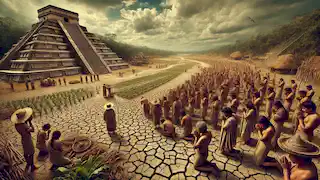The Story of Kukulkan
Reading Time: 8 min

About Story: The Story of Kukulkan is a Myth from mexico set in the Ancient. This Dramatic tale explores themes of Wisdom and is suitable for All Ages. It offers Cultural insights. A timeless journey of knowledge, wisdom, and celestial power in ancient Maya myth.
In the dense, green heart of the Yucatán jungle, centuries before the Spanish ships touched the New World’s shores, the ancient Maya civilization flourished. Here, beneath towering trees and under the watchful gaze of the gods, they built vast cities, studied the stars, and worshipped a pantheon of deities. Among these gods, one held a special place—a deity who embodied both life and destruction, wisdom and power. This was Kukulkan, the feathered serpent, the god who descended from the heavens, bringing the sacred knowledge of the cosmos to the Maya. Kukulkan was not always a deity in the minds of the ancient Maya. Legends tell that he was once a great leader, a man who bridged the divide between humanity and the gods. He was born in a village nestled at the edge of a river, under the auspices of an auspicious night sky filled with stars. Even as a child, Kukulkan showed an unusual understanding of the world. He seemed to hear the whispers of the forest, understand the language of animals, and comprehend the mysteries of the stars above. As he grew older, Kukulkan’s influence expanded. He was known for his wisdom, his fair judgment, and his undeniable aura of power. Villagers from across the lands traveled to seek his counsel. Legends say that Kukulkan spoke with the voice of the jaguar and moved with the grace of a serpent. His wisdom brought prosperity to the villages around him, and soon, his fame spread across the Yucatán. The people began to worship him as a god among men, seeing in him the qualities of both heaven and earth. His serpent-like agility and jaguar strength became symbols of divine power, and tales of his miracles began to emerge. Kukulkan was said to have healed the sick, summoned rains during droughts, and even performed feats of resurrection for fallen warriors. Eventually, as his mortal life drew to a close, Kukulkan vanished from the earthly realm, leaving only legends of his greatness behind. But the story of Kukulkan did not end with his departure. The Maya believed that he transcended into the celestial realm, where he ascended as a god. From then on, they honored him as Kukulkan, the feathered serpent, a deity who bridged the realms of gods and men. He became the god of wind, rain, and storms, and his divine essence was present in every thunderclap, every flash of lightning, and every gust of wind that rustled the jungle leaves. In the ancient Maya belief, Kukulkan was not only a god of nature but also a god of wisdom and knowledge. Legends tell that after his ascension, he returned to the earth in the form of a feathered serpent, descending from the heavens to impart the sacred knowledge of the cosmos to the Maya people. His wisdom was vast, encompassing the sciences of mathematics, astronomy, agriculture, and spirituality. According to Maya lore, Kukulkan’s return was marked by a great celestial event. A star appeared in the sky, brighter than any other. The Maya priests, skilled astronomers in their own right, gathered at their temples to witness this phenomenon. They observed the star’s movements, tracking its path through the heavens, until it finally came to rest above the Temple of Kukulkan in Chichen Itza. On that sacred night, as the star reached its zenith, Kukulkan appeared, gliding through the jungle as a massive feathered serpent, his scales shimmering in hues of emerald and gold. He descended upon the temple, and with him, he brought the knowledge that would transform the Maya civilization forever. Through Kukulkan’s teachings, the Maya learned to harness the cycles of nature, predict eclipses, and understand the complex interplay between the earth and the cosmos. The Maya built grand cities in his honor, with pyramids that mirrored the heavens and aligned with the celestial bodies. The most famous of these was the Temple of Kukulkan in Chichen Itza, a towering structure that captured the cycles of the sun and moon. On the equinoxes, as the sun set, the temple’s shadows would cast the image of a serpent descending its steps, symbolizing Kukulkan’s eternal return to the earth and his blessing upon the Maya people. With the blessings of Kukulkan, the Maya civilization entered a period of prosperity. Crops flourished, art and literature blossomed, and the people enjoyed a harmonious balance with nature. However, with this prosperity came challenges. Rival cities vied for dominance, wars erupted, and the delicate balance of power began to shift. The priests, who served as intermediaries between Kukulkan and the people, were tasked with maintaining this balance. They interpreted the messages of the heavens, reading the stars and planets to determine the god’s will. However, as the conflicts grew more intense, the priests found themselves at odds with the warlords who sought power and control over the region. One priest, named Itzamna, was especially devoted to Kukulkan. He believed that the true power of Kukulkan lay not in warfare but in knowledge and harmony. He traveled from city to city, teaching the people the importance of Kukulkan’s message. However, his words were often met with resistance, especially from those who desired control over the fertile lands and sacred temples. Despite the turmoil, Itzamna remained steadfast in his devotion. He prayed at the Temple of Kukulkan, seeking guidance from the god. One night, as he meditated, he felt a powerful presence descend upon him. In a vision, Kukulkan appeared before him as a radiant feathered serpent, his voice a rumble like distant thunder. Kukulkan spoke of a great trial that would come upon the land, a time when the people would be tested. He told Itzamna that only through unity and wisdom could they survive the challenges ahead. Inspired by this vision, Itzamna traveled back to the cities, spreading the message of unity. Though he faced opposition, his words resonated with many, and a movement began to grow. As foretold by Kukulkan, a time of great hardship came upon the Maya. A drought struck the land, withering crops and causing rivers to dry up. The people turned to their gods, praying for rain, but the skies remained silent. Desperation grew, and many began to doubt the power of Kukulkan. Some believed he had abandoned them, while others felt they had angered the gods. In this time of despair, Itzamna gathered the people at the Temple of Kukulkan. He reminded them of the god’s teachings, urging them to remain faithful. As the sun set over the temple, the people knelt in prayer, their voices rising into the darkening sky. At that moment, a miracle occurred. Thunder echoed through the heavens, and a flash of lightning illuminated the clouds. Rain began to pour, soaking the parched earth. The people rejoiced, lifting their hands in gratitude. They believed Kukulkan had returned, bringing life back to the land. But this was not the end of Kukulkan’s presence among them. The rains continued, and with each storm, the people felt his power. The jungle flourished once more, the rivers filled, and life returned to the land. The Maya believed that Kukulkan had truly descended upon them, blessing them with his presence. The story of Kukulkan did not end with the rains. His legacy lived on, passed down through generations. The Maya continued to honor him, building temples in his name and preserving his teachings. The Temple of Kukulkan in Chichen Itza became a place of pilgrimage, where people came to pay homage to the feathered serpent. Kukulkan’s story became woven into the fabric of Maya culture. His image adorned their art, his teachings were inscribed in their codices, and his presence was felt in every aspect of their lives. For the Maya, Kukulkan was not just a god but a guide, a symbol of wisdom and power that transcended the mortal realm. Even today, the story of Kukulkan lives on. His legend endures, a reminder of the ancient Maya’s connection to the cosmos, their respect for nature, and their reverence for the mysteries of life. As long as the stars shine above and the jungle whispers below, the story of Kukulkan, the feathered serpent, will continue to inspire those who seek knowledge, wisdom, and harmony with the world around them.The Rise of Kukulkan

The Arrival of Knowledge

The Challenges of the People

The Final Descent
The Legacy of Kukulkan


















